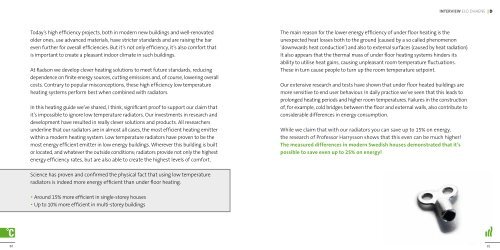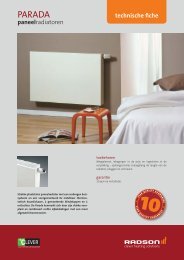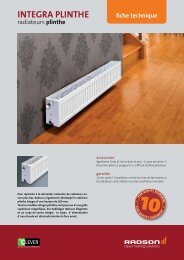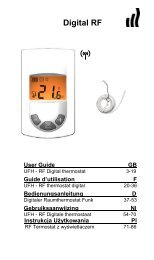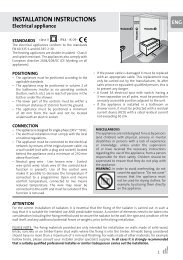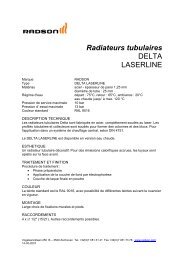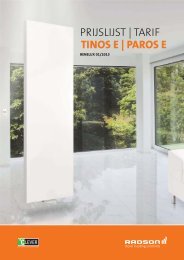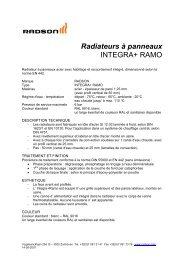Download - Purmo Radson
Download - Purmo Radson
Download - Purmo Radson
You also want an ePaper? Increase the reach of your titles
YUMPU automatically turns print PDFs into web optimized ePapers that Google loves.
interview elo dhaene | D<br />
Today’s high efficiency projects, both in modern new buildings and well-renovated<br />
older ones, use advanced materials, have stricter standards and are raising the bar<br />
even further for overall efficiencies. But it’s not only efficiency, it’s also comfort that<br />
is important to create a pleasant indoor climate in such buildings.<br />
At <strong>Radson</strong> we develop clever heating solutions to meet future standards, reducing<br />
dependence on finite energy sources, cutting emissions and, of course, lowering overall<br />
costs. Contrary to popular misconceptions, these high efficiency low temperature<br />
heating systems perform best when combined with radiators.<br />
In this heating guide we’ve shared, I think, significant proof to support our claim that<br />
it’s impossible to ignore low temperature radiators. Our investments in research and<br />
development have resulted in really clever solutions and products. All researchers<br />
underline that our radiators are in almost all cases, the most efficient heating emitter<br />
within a modern heating system. Low temperature radiators have proven to be the<br />
most energy efficient emitter in low energy buildings. Wherever this building is built<br />
or located, and whatever the outside conditions; radiators provide not only the highest<br />
energy efficiency rates, but are also able to create the highest levels of comfort.<br />
The main reason for the lower energy efficiency of under floor heating is the<br />
unexpected heat losses both to the ground (caused by a so called phenomenon<br />
‘downwards heat conduction’) and also to external surfaces (caused by heat radiation).<br />
It also appears that the thermal mass of under floor heating systems hinders its<br />
ability to utilise heat gains, causing unpleasant room temperature fluctuations.<br />
These in turn cause people to turn up the room temperature setpoint.<br />
Our extensive research and tests have shown that under floor heated buildings are<br />
more sensitive to end user behaviour. In daily practice we’ve seen that this leads to<br />
prolonged heating periods and higher room temperatures. Failures in the construction<br />
of, for example, cold bridges between the floor and external walls, also contribute to<br />
considerable differences in energy consumption.<br />
While we claim that with our radiators you can save up to 15% on energy,<br />
the research of Professor Harrysson shows that this even can be much higher!<br />
The measured differences in modern Swedish houses demonstrated that it’s<br />
possible to save even up to 25% on energy!<br />
Science has proven and confirmed the physical fact that using low temperature<br />
radiators is indeed more energy efficient than under floor heating.<br />
• Around 15% more efficient in single-storey houses<br />
• Up to 10% more efficient in multi-storey buildings<br />
80<br />
81


